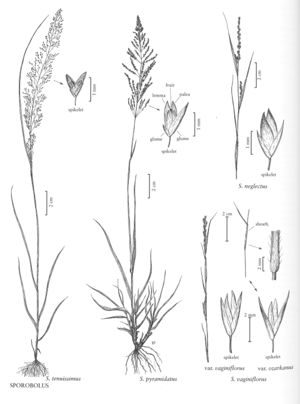Difference between revisions of "Sporobolus pyramidatus"
FNA>Volume Importer |
FNA>Volume Importer |
||
| Line 26: | Line 26: | ||
-->{{Treatment/Body | -->{{Treatment/Body | ||
|distribution=Puerto Rico;Md.;Kans.;Okla.;Colo.;N.Mex.;Tex.;La.;Pa.;Mo.;Nebr.;N.Y.;Pacific Islands (Hawaii);Ill.;Utah;Virgin Islands;Ariz.;Fla.;Ark. | |distribution=Puerto Rico;Md.;Kans.;Okla.;Colo.;N.Mex.;Tex.;La.;Pa.;Mo.;Nebr.;N.Y.;Pacific Islands (Hawaii);Ill.;Utah;Virgin Islands;Ariz.;Fla.;Ark. | ||
| − | |discussion=<p | + | |discussion=<p>Sporobolus pyramidatus is native to the Americas, extending from the southern United States to Argentina. It grows in disturbed soils, roadsides, railways, coastal sands, and alluvial slopes in many plant communities, at elevations from 0-1500 m. Morphologically, it is very similar to the Eastern Hemisphere S. coromandelianus (Retz.) Kunth, suggesting that they are closely related.</p> |
|tables= | |tables= | ||
|references= | |references= | ||
| Line 42: | Line 42: | ||
|basionyms= | |basionyms= | ||
|family=Poaceae | |family=Poaceae | ||
| + | |illustrator=Linda A. Vorobik and Hana Pazdírková | ||
|distribution=Puerto Rico;Md.;Kans.;Okla.;Colo.;N.Mex.;Tex.;La.;Pa.;Mo.;Nebr.;N.Y.;Pacific Islands (Hawaii);Ill.;Utah;Virgin Islands;Ariz.;Fla.;Ark. | |distribution=Puerto Rico;Md.;Kans.;Okla.;Colo.;N.Mex.;Tex.;La.;Pa.;Mo.;Nebr.;N.Y.;Pacific Islands (Hawaii);Ill.;Utah;Virgin Islands;Ariz.;Fla.;Ark. | ||
|reference=None | |reference=None | ||
| Line 47: | Line 48: | ||
|publication year= | |publication year= | ||
|special status= | |special status= | ||
| − | |source xml=https:// | + | |source xml=https://bibilujan@bitbucket.org/aafc-mbb/fna-data-curation.git/src/314eb390f968962f596ae85f506b4b3db8683b1b/coarse_grained_fna_xml/V25/V25_188.xml |
|subfamily=Poaceae subfam. Chloridoideae | |subfamily=Poaceae subfam. Chloridoideae | ||
|tribe=Poaceae tribe Cynodonteae | |tribe=Poaceae tribe Cynodonteae | ||
Revision as of 17:17, 30 October 2019
Plants annual, or short-lived perennials flowering in the first year; cespitose, not rhizomatous. Culms 7-35(60) cm, erect or decumbent. Sheaths rounded below, margins and apices hairy, hairs to 3 mm; ligules 0.3-1 mm; blades 2-12(20) cm long, 2-6 mm wide, flat, abaxial surface glabrous, adaxial surface scabridulous, sometimes sparsely hispid, margins ciliate-pectinate. Panicles 4-15(18) cm long, 0.3-6 cm wide, open (contracted when immature), pyramidal; lower nodes with 7-12(15) branches; primary branches 0.5-4.5 cm, spreading 30-90° from the rachis, with elongated glands, without spikelets on the lower 1/3 – 1/2, secondary branches appressed; pedicels 0.1-0.5 mm, appressed. Spikelets 1.2-1.8 mm, plumbeous or brownish, often secund along the branch. Glumes unequal, ovate to obovate, membranous; lower glumes 0.3-0.7 mm, without midveins; upper glumes 1.2-1.8 mm, at least 2/3 as long as the florets, often longer; lemmas 1.2-1.7 mm, ovate to elliptic, membranous, glabrous, acute; paleas 1.1-1.6 mm, ovate to elliptic, membranous, glabrous; anthers 0.2-0.4 mm, yellowish or purplish. Fruits 0.6-1 mm, obovoid, faintly striate, light brownish. 2n = 24, 36, 54.
Distribution
Puerto Rico, Md., Kans., Okla., Colo., N.Mex., Tex., La., Pa., Mo., Nebr., N.Y., Pacific Islands (Hawaii), Ill., Utah, Virgin Islands, Ariz., Fla., Ark.
Discussion
Sporobolus pyramidatus is native to the Americas, extending from the southern United States to Argentina. It grows in disturbed soils, roadsides, railways, coastal sands, and alluvial slopes in many plant communities, at elevations from 0-1500 m. Morphologically, it is very similar to the Eastern Hemisphere S. coromandelianus (Retz.) Kunth, suggesting that they are closely related.
Selected References
None.
